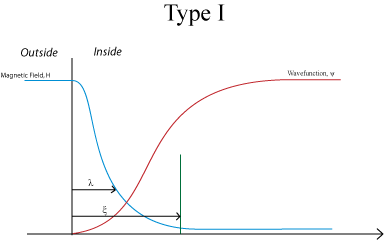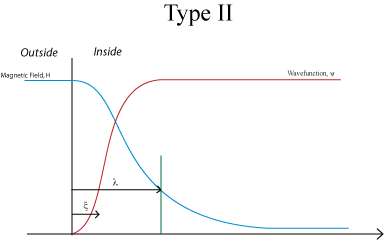Type I vs Type II
As scientists began to probe the exciting new properties of superconductors, they discovered that superconductors did have limitations apart from a maximum operating temperature. Although currents can flow without any energy dissipation, superconductivity is destroyed by the application of a sufficiently large magnetic field or if the flowing electrical current density exceeds a critical value.
The critical magnetic field depends on how far below the critical temperature the material is. The graph below shows this dependence.
As more superconducting materials were discovered, it was found that they fell into one of two classes, or “Types” with regard to their magnetic properties, and in particular in the way that they expelled magnetic fields. “Type I” superconductors have a sharp transition from the superconducting state where all magnetic flux is expelled to the normal state.
Type II superconductors, on the other hand exhibit similar behaviour by completely excluding a magnetic field below a lower critical field value and becoming normal again at an upper critical field. However, when the magnetic field is between these lower and upper critical fields, the superconductor enters a “mixed state” where there is partial penetration of flux. In order to lower the overall magnetic energy, the material allows bundles of flux to penetrate the sample. Within these filaments, the magnetic field is high and the superconductor reverts to normal conducting behaviour. Around each of the filaments is a circulating vortex of screening current which opposes the field inside the core. This arrangement ensures that the material outside these bundles remains in the superconducting state. The graph below shows the differing dependence of magnetic field on temperature which characterises type II superconductors.
The so-called flux vortices often arrange themselves into regular periodic structures. They can be visualised by covering the surface with a coagulation of very fine ferromagnetic particles. The animation below shows a micrograph taken of a type II superconductor in the mixed state and how it arises from the partial penetration of flux.
The sample as a whole continues to have zero resistance as current flows by the easiest path and as there are superconducting regions, current can still flow without energy loss. It must be noted however, that if the vortices move they will dissipate energy. For the superconductor to remain lossless, the vortices must be pinned in place by defects within the crystal structure of the material. Current research aims to understand and pin the resistive motion of flux vortices in applied superconductors, with the aim of creating high critical current materials for applications.
The reason that some superconductors form a mixed state relies on the relationship between the coherence length, ξ, and the London penetration depth, λ. As well as being a description of the distance over which Cooper pairs can be considered to be correlated, the coherence length also describes the distance over which the superconductor can be represented by a wavefunction. For reasons we will not go into, if the penetration depth, λ, is greater than the coherence length, ξ it is thermodynamically favourable for the magnetic field to penetrate the specimen and it will be type II. This is shown schematically in the diagram below.
 |
 |
|
Relationship between the coherence length and penetration depth for Type I and Type II superconductors |
||

